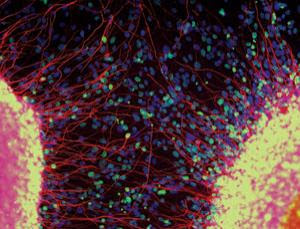Últimos assuntos
Tópicos mais visitados
Tópicos mais ativos

Ateu defende ensino criacionista e livro de Meyer
Página 1 de 1
20032010

 Ateu defende ensino criacionista e livro de Meyer
Ateu defende ensino criacionista e livro de Meyer

Ateu defende ensino criacionista e livro de Meyer
O proeminente ateu Thomas Nagel, filósofo respeitado e influente, laureado com o prêmio Schock na categoria Filosofia e Lógica, escolheu Signature in the Cell: DNA and the evidence for Intelligent Design, de Stephen C. Meyer, como um dos melhores livros de 2009. De quebra, ele ainda defendeu recentemente ("Public Education and Intelligent Design", Philosophy & Public Affairs 2008) que o criacionismo não é pseudociência, é um tipo de ciência e não deve ser proibido. Pra variar, a reação dos ateus militantes foi de puro fanatismo. Foi o caso de Brian Leiter e sua clara tentativa de silenciar Nagel.
(Colaboração: Ronaldo Ewerton)
Nota: Ainda não entendi o que as editoras brasileiras estão esperando para traduzir e publicar o livro de Meyer. Parece que deram as mãos ao ateísmo militante de Richard Dawkins et al, pois é só ele escrever algo novo que já sai por aqui.[MB]
Nagel justifica sua indicação e diz que é preciso olhar para a natureza como algo além daquilo que é explicado pela mera física.
Veja a reação do ateus:
http://animot.blogspot.com/2009/12/thomas-nagel-jogou-reputacao-no-lixo.html
Signature in the Cell Named One of Top Books of the Year by Times Literary Supplement
Stephen Meyer’s Signature in the Cell: DNA and the Evidence for Intelligent Design is being named one of the top books of 2009 in the prestigious Times Literary Supplement (TLS) annual “Books of the Year” issue, officially due out later this week. The selection was made by prominent philosopher (and noted atheist) Thomas Nagel at New York University. The books issue is not online yet, but the TLS website has posted a preview of Nagel’s endorsement of the book:
Stephen C. Meyer’s Signature in the Cell: DNA and the evidence for Intelligent Design (HarperCollins) is a detailed account of the problem of how life came into existence from lifeless matter – something that had to happen before the process of biological evolution could begin. The controversy over Intelligent Design has so far focused mainly on whether the evolution of life since its beginnings can be explained entirely by natural selection and other non-purposive causes. Meyer takes up the prior question of how the immensely complex and exquisitely functional chemical structure of DNA, which cannot be explained by natural selection because it makes natural selection possible, could have originated without an intentional cause. He examines the history and present state of research on non-purposive chemical explanations of the origin of life, and argues that the available evidence offers no prospect of a credible naturalistic alternative to the hypothesis of an intentional cause. Meyer is a Christian, but atheists, and theists who believe God never intervenes in the natural world, will be instructed by his careful presentation of this fiendishly difficult problem.
http://www.uncommondescent.com/intelligent-design/meyers-signature-in-the-cell-one-of-thomas-nagels-top-two-books-of-2009/
http://greatcloud.wordpress.com/2009/11/29/thomas-nagel-selects-signature-in-the-cell-as-one-of-top-books-of-2009/
Sobre a inteligência encontrada nas células: mero acaso, fortuita necessidade ou design inteligente?
The secrets of intelligence lie within a single cell
26 April 2010 by Brian J. Ford
Magazine issue 2757.
LATE at night on a sultry evening, I watch intently as the predator senses its prey, gathers itself, and strikes. It could be a polecat, or even a mantis - but in fact it's a microbe. The microscopic world of the single, living cell mirrors our own in so many ways: cells are essentially autonomous, sentient and ingenious. In the lives of single cells we can perceive the roots of our own intelligence.
Molecular biology and genetics have driven the biosciences, but have not given us the miraculous new insights we were led to expect. From professional biologists to schoolchildren, people are concentrating on the minutiae of what goes on in the deepest recesses of the cell. For me, however, this misses out on life in the round: it is only when we look at the living cell as a whole organism that wonderful realities emerge that will alter our perception not only of how single cells enact their intricate lives but what we humans truly are.The problem is that whole-cell biology is not popular. Microscopy is hell-bent on increased resolution and ever higher magnification, as though we could learn more about animal behaviour by putting a bacon sandwich under lenses of increasing power. We know much about what goes on within parts of a cell, but so much less about how whole cells conduct their lives.
Modelling the neuron as little more than a simple on/off switch is a big mistake (Image: Dan Webber)
Currently, cell biology deals largely with the components within cells, and systems biology with how the components interact. There is nothing to counterbalance this reductionism with a focus on how whole cells behave. Molecular biology and genetics are the wrong sciences to tackle the task.
Let's take a look at some of the evidence for ingenuity and intelligence in cells that is missing from the curriculum. Take the red algae Rhodophyta, in which many species carry out remarkable repairs to damaged cells. Cut a filament of Antithamnion cells so the cell is cut across and the cytoplasm escapes into the surrounding aquatic medium. All that remains are two fragments of empty, disrupted cell wall lying adjacent to, but separate from, each other. Within 24 hours, however, the adjacent cells have made good the damage, the empty cell space has been restored to full activity, and the cell walls meticulously realigned and seamlessly repaired.
The only place where this can happen is in the lab. In nature, the broken ends of the severed cell would nearly always end up remote from each other, so selection in favour of an automatic repair mechanism through Darwinian evolution would be impossible. Yet something amazing is happening here: because the damage to the Antithamnion filament is unforeseeable, the organism faces a situation for which it has not been able to adapt, and is therefore unable to call upon inbuilt responses. It has to use some sort of problem-solving ingenuity instead.
We regard amoebas as simple and crude. Yet many types of amoeba construct glassy shells by picking up sand grains from the mud in which they live. The typical Difflugia shell, for example, is shaped like a vase, and has a remarkable symmetry.
Compare this with the better known behaviour of a caddis fly larva. This maggot hunts around the bottom of the pond for suitable scraps of detritus with which to construct a home. Waterlogged wood is cemented together with pondweed until the larva has formed a protective covering for its nakedness. You might think this comparable to the home built by the testate amoeba, yet the amoeba lacks the jaws, eyes, muscles, limbs, cement glands and brain the caddis fly larva relies on for its skills. We just don't know how this single-celled organism builds its shell, and molecular biology can never tell us why. While the home of the caddis fly larva is crude and roughly assembled, that of the testate amoeba is meticulously crafted - and it's all made by a single cell.
The products of the caddis fly larva and the amoeba, and the powers of red algae, are about more than ingenuity: they pose important questions about cell intelligence. After all, whole living cells are primarily autonomous, and carry out their daily tasks with little external mediation. They are not subservient nanobots, they create and regulate activity, respond to current conditions and, crucially, take decisions to deal with unforeseen difficulties.
...
Read more here/Leia mais aqui: New Scientist
+++++
On Intelligence in Cells: The Case for Whole Cell Biology
Author: Ford, Brian J.1
Source: Interdisciplinary Science Reviews, Volume 34, Number 4, December 2009 , pp. 350-365(16)
Publisher: Maney Publishing
Abstract:
Biology needs revolution. All my adult life, I have been lost with admiration for the achievements in molecular biology and genetics, and I have come to know many of the main proponents. Yet there is an alternative aspect: in studying the minutiae, we have lost sight of the whole cell as organism. Living cells within the body are modelled in this paper as coordinated but essentially autonomous entities. We shall see how independent cells in nature have remarkable abilities to make decisions and take constructive action, which correlate with the definitions of intelligence.
We are taught that the brain controls everything that goes on in the body, yet in this paper, we discover that most of the body's cells are invisible to the brain and are indifferent to its regulation. We encounter a novel model of the brain in which the neuron is viewed as an ingenious entity that 'thinks' within itself. The brain is not a 'super computer' but an entire community of them. We shall set the reductionism of molecular biology and the elementary mechanisms of genetics into a more realistic perspective and will recognize that the cell as organism matters above all. In future, whole cell biology should become the focus of the biosciences and the intelligent cell lies at its heart.
Keywords: MICROSCOPE; MICROBIOLOGY; CELL; INTELLIGENCE; GENETICS; MOLECULAR BIOLOGY; BEHAVIOUR
Document Type: Research article
DOI: 10.1179/030801809X12529269201282
Affiliations: 1: Gonville and Caius College, University of Cambridge, UK;, Email: mail@brianjford.com
+++++
Professores, pesquisadores e alunos de universidades públicas e privadas com acesso ao site CAPES/Periódicos podem ler gratuitamente este artigo do Interdisciplinary Science Reviews e de mais 22.440 publicações científicas.
+++++
NOTA IMPERTINENTE DESTE BLOGGER:
Ford não defende a teoria do Design Inteligente e tampouco faz parte do movimento do DI, mas este é um artigo em que as teses do Design Inteligente de complexidade irredutível e informação complexa especificada são defendidas sem querer querendo, pois o DESIGN é real e pode ser empiricamente detectado, não é ILUSÓRIO como afirma e impõe goela abaixo a Nomenklatura científica.
A biologia precisa de uma revolução, disse Ford em 2009. Nós do Design Inteligente estamos promovendo esta revolução há mais de uma década. A duras penas. Sendo 'expulsos' da comunidade científica. Não tendo papers, nem artigos submetidos para journals ou conferências/simpósios/seminários/oficinas aprovados. eu sei do que estou falando. Sou exemplo vivo disso. Mas, o DI veio para ficar, e, ousados que somos (bota ousados nisso!!!), predizemos: cada vez mais serão encontrados camadas de complexidade nas coisas bióticas, demonstrando que o atual paradigma reducionista deve ser IMEDIATAMENTE abandonado, mesmo que nada tenhamos (será que não temos, ou será que NÃO QUEREM) para por no lugar.
Que venga la nueva teoría de evolución -- a SÍNTESE EVOLUTIVA AMPLIADA, que, por essas e outras evidências encontradas na natureza não pode e nem deve ser selecionista!
Darwin morreu, gente!!! Viva Darwin!!!

Carlstadt- Administrador

- Mensagens : 1031
Idade : 48
Inscrição : 19/04/2008
 Tópicos semelhantes
Tópicos semelhantes» Ex-ateu lança livro no qual defende Criacionismo e o dilúvio bíblico
» Ateu defende vegetarianismo
» O novo livro "Signature of Controversy" responde aos críticos de Steve Meyer
» Enquanto mãe defende ativamente cristianismo Brad Pitt confessa ser ateu ? ?
» Pastor afirma que ateu fez “favor” ao cristianismo quando publicou livro afirmando que Deus é um delírio
» Ateu defende vegetarianismo
» O novo livro "Signature of Controversy" responde aos críticos de Steve Meyer
» Enquanto mãe defende ativamente cristianismo Brad Pitt confessa ser ateu ? ?
» Pastor afirma que ateu fez “favor” ao cristianismo quando publicou livro afirmando que Deus é um delírio
Permissões neste sub-fórum
Não podes responder a tópicos
 Início
Início









 Seja fã Forumeiros
Seja fã Forumeiros
» Acordem adventistas...
» O que Vestir Para Ir à Igreja?
» Ir para o céu?
» Chat do Forum
» TV Novo Tempo...
» Lutas de MMA são usadas como estratégia por Igreja Evangélica para atrair mais fiéis
» Lew Wallace, autor do célebre livro «Ben-Hur», converteu-se quando o escrevia
» Ex-pastor evangélico é batizado no Pará
» Citações de Ellen White sobre a Vida em Outros Planetas Não Caídos em Pecado
» Viagem ao Sobrenatural - Roger Morneau
» As aparições de Jesus após sua morte não poderiam ter sido alucinações?